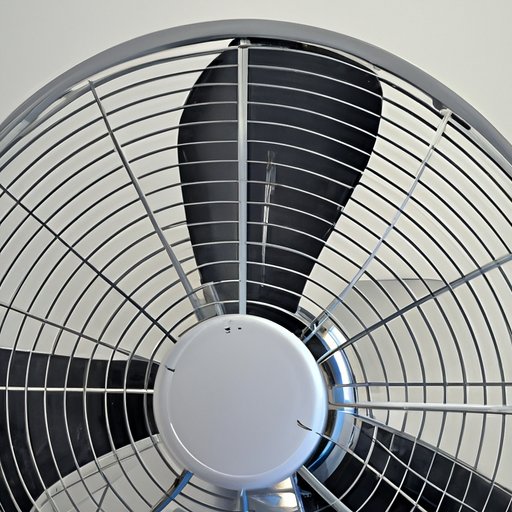Introduction
Have you ever wondered which way your fan should be rotating in the summer for optimal cooling? Have you found yourself confused about clockwise and counterclockwise rotations and which direction to choose? You’re not alone! Understanding fan direction and how to use it to your advantage can make a big difference in staying cool during the summer months. In this article, we’ll explore the importance of knowing which way your fan should go in summer and share tips and tricks for optimal cooling.
Beat the Heat: The Importance of Knowing Which Way Your Fan Should Go in Summer
Fans are a cost-effective and easy way to cool down a room. They work by creating a wind-chill effect, blowing away the warm air that surrounds your body and allowing cooler air to reach your skin. Using a fan instead of air conditioning can save money on your energy bills while also reducing your carbon footprint.
One crucial aspect of using a fan for cooling is the direction in which it spins. This direction determines the airflow and temperature of the room. By changing the fan direction based on the season, you can maximize its cooling power and create a comfortable environment.
Clockwise or Counterclockwise: Which Way Should Your Fan Spin in the Summer?
Fans can spin in either a clockwise or counterclockwise direction, depending on the switch on the unit. Both directions have advantages, but it is essential to know which way your fan should move during summer to get the most significant benefits.
During summer, the best direction for your fan to spin is counterclockwise. This direction creates a downward airflow that moves and cools the surrounding air. The gentle breeze produced by the fan should be noticeable but not too strong to make you feel cold.
However, there are some factors to consider when choosing the right direction, such as room layout, fan size, and ceiling height. A fan that is too small or placed too high may not produce enough airflow to offer relief, regardless of its direction.
Summer Fan Guide: A Simple Explanation of Fan Rotation for Optimal Cooling
Determining the right direction for your fan is relatively simple. Stand under the fan and observe the rotation. If the blades move in a counterclockwise direction, you’re good to go for summertime cooling. If they move clockwise, there is a switch on the fan’s unit that you can flip to change the direction.
Finding the right balance between comfort and energy efficiency can be challenging. However, setting your fan to the right direction and speed can make it more efficient at cooling your home. Slow fan speed is ideal for day-to-day use, while high speed can create a more refreshing breeze.
Safety precautions should be taken when installing or adjusting a ceiling fan to prevent accidents. Always follow the manufacturer’s instructions and turn off the power before making any changes.
Don’t Sweat the Small Stuff: How Understanding Fan Direction Can Save You Money This Summer
Using a fan efficiently in the summer can lower your energy bills and help you save money. Running an air conditioner consumes more energy and increases your monthly utility costs. In contrast, using a fan only costs a few cents an hour, making it a cost-effective solution for staying cool.
By understanding the right direction for your fan, you can make the most out of its cooling power. A counterclockwise rotation can lower your room temperature by up to eight degrees, according to experts. This increase in cooling power means you can turn your air conditioning up a few degrees, reducing your energy consumption.
The Science of Fan Direction: How Your Ceiling Fan Can Keep You Cool All Summer Long
The science behind fan direction is straightforward. Counterclockwise fan rotation creates a downdraft, pushing cold air down and creating a breeze. This airflow picks up any stagnant heat and pulls it towards the ceiling, where it is distributed away from you.
By picking the right fan direction, you can create an environment that feels five to eight degrees cooler and reduce your energy consumption by up to 40 percent. Using a ceiling fan is a better option than floor fans because they circulate air more efficiently and cover a more extensive area.
Fan Rotation Hacks: Tips and Tricks for Keeping Cool During the Summer Months
There are several creative solutions and hacks you can use to maximize the benefits of your fan during the summer months. One trick is to reduce the heat generated by appliances and lighting. Incandescent bulbs and electronics produce more heat and increase your room temperature. By replacing them with LED lights and energy-efficient devices, you can keep your home cooler.
Another easy trick is to adjust your furniture and decor, so they don’t obstruct the airflow. Rearrange your seating areas and avoid blocking vents or registers. You can create an even flow of cold air by placing a bowl filled with ice in front of the fan.
Conclusion
Understanding which way a fan should go in the summer can make a huge difference in staying cool and maintaining comfort and energy efficiency. By picking the correct direction and using your fan mindfully, you can reduce your energy bills, lower your carbon footprint, and make the summer months more enjoyable. Try out our tips and tricks and create an environment that feels cool and refreshing all summer long.
